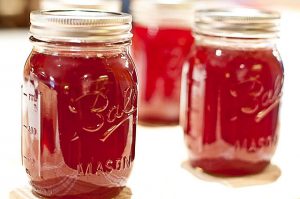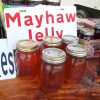Muscadine, the Native Grape of North America

On a recent road trip, I had the occasion to stop at one of those super travel stations. You know the ones I mean--gasoline, snacks, souvenirs, clean restrooms, and usually a barbeque or fast food restaurant. While browsing the aisles, I happened to notice a wide selection of what appeared to be jars of home-canned fruits, compotes, jams, and jellies. And there, right between the "Homemade Pear Butter" and "Brandied Peach Preserves," was a jar of sweet goodness that made my mouth salivate, a treat my tongue hadn't experienced in at least three decades--a Ball jar of clear, deep violet colored muscadine jelly. An absolute must-have!
As I pulled my car back onto the highway, jelly in tow, my mind wandered back to my youth when my parents would take me to visit grandmother's farm in southeastern Oklahoma. And of course, most of the time one or two of my mother's sisters or brothers or both were also there, as well as four to six cousins. As there was little or no TV reception at the farm, we kids would spend our days playing in the barn or smoke house or down at the stock tank fishing. Occasionally, one of  the older cousins would take us younger ones beyond the pasture and past the peanut fields down to the marshes where thick vines grew wild, climbing high into the trees. And there we would pick muscadines, filling our buckets with those deep purple, almost black fruits that were as big around as quarters. And being the kids we were, we would swing from the vines and eat so many of the luscious berries that our fingers and tongues would become discolored from chewing on the skins, trying to get out as much of the flavor as possible.
the older cousins would take us younger ones beyond the pasture and past the peanut fields down to the marshes where thick vines grew wild, climbing high into the trees. And there we would pick muscadines, filling our buckets with those deep purple, almost black fruits that were as big around as quarters. And being the kids we were, we would swing from the vines and eat so many of the luscious berries that our fingers and tongues would become discolored from chewing on the skins, trying to get out as much of the flavor as possible.
When we got back to the farmhouse, my mother, grandmother, and aunts would wash, cook, and strain the fruit, "putting up" several dozen jars of homemade muscadine jelly. And since my father was partial to preserves instead of jelly, grandmother would always make sure her son-in-law had a few jars that included the skins (or hulls, as we called them), and pulp. Of course a few seeds were always able to sneak in as well, but to my dad that didn't seem to matter.
There was nothing better than one of my grandmother's hot biscuits slathered with fresh churned butter and topped with a thick layer of that delectable muscadine jelly.
 Long before European and Spanish explorers set foot on American soil, the Cherokee and Creek Indians were making raisins, dumplings, drinks, and poultices from wild grapes they called muscadines.
Long before European and Spanish explorers set foot on American soil, the Cherokee and Creek Indians were making raisins, dumplings, drinks, and poultices from wild grapes they called muscadines.
Native only to the Southeastern and Southern United States, muscadines thrived in the warm, humid climate so prevalent in those states. In the mid-1600s when Arthur Barlowe, an English sea captain and explorer serving under the direction of Sir Walter Raleigh, landed on the banks of what is now Roanoke Island, he was so taken by the number of muscadine vines and fruit he saw that he wrote to Raleigh extolling that the fruitful land was "full of grapes, that I think in all the world, like abundance is not to be found."
 When Raleigh came to North Carolina in 1585, he discovered what is thought today to be the oldest grapevine in the United States, describing it as having a trunk two feet thick and stretching over one-half an acre long and coiling up tree trunks growing sixty feet tall. Actually this 400 year old producing "mother vine" is of the variety called scuppernong muscadine. The scuppernong was the first native American grape to be culitvated and is the state fruit of North Carolina.
When Raleigh came to North Carolina in 1585, he discovered what is thought today to be the oldest grapevine in the United States, describing it as having a trunk two feet thick and stretching over one-half an acre long and coiling up tree trunks growing sixty feet tall. Actually this 400 year old producing "mother vine" is of the variety called scuppernong muscadine. The scuppernong was the first native American grape to be culitvated and is the state fruit of North Carolina.
Wild muscadine vines can be found growing from southern Delaware, southward along the Atlantic coast to northern Florida, and westward to Missouri, Arkansas, Louisiana, and Texas. And because the muscadine is a native plant, its vines are practically immune to the fungus, bacteria, and plant pests that can destroy European grapevines. Muscadines grow best in fertile sandy loam of well-drained bottom lands that are subjected to neither extended drought or waterlogging.
 Today, there are more than 300 muscadine cultivars, ranging in color from black to whitish bronze to dark purple. There are also red varieties and even some that remain green through maturity. The skins of muscadines are thick and so tough that many people bite off a small piece and suck out the sweet flesh inside. But it is the skins and seeds that excite many of today's food scientists and nutritionists. They have found that powdered muscadine puree has more dietary fiber than oat or rice bran and can therefore help provide a wide range of health benefits including lowering blood pressure, triglycerides, and cholesterol levels.
Today, there are more than 300 muscadine cultivars, ranging in color from black to whitish bronze to dark purple. There are also red varieties and even some that remain green through maturity. The skins of muscadines are thick and so tough that many people bite off a small piece and suck out the sweet flesh inside. But it is the skins and seeds that excite many of today's food scientists and nutritionists. They have found that powdered muscadine puree has more dietary fiber than oat or rice bran and can therefore help provide a wide range of health benefits including lowering blood pressure, triglycerides, and cholesterol levels.
 Research has also found that the muscadine is extremely high in resveratrol, the phytochemical found in red wine and thought to be the underlying reason that the French have such a low incidence of coronary heart disease. In fact, one serving of muscadine jam, one medium muscadine muffin, or two ounces of muscadine juice contain as much resveratrol as four ounces of red wine.
Research has also found that the muscadine is extremely high in resveratrol, the phytochemical found in red wine and thought to be the underlying reason that the French have such a low incidence of coronary heart disease. In fact, one serving of muscadine jam, one medium muscadine muffin, or two ounces of muscadine juice contain as much resveratrol as four ounces of red wine.
So there you go. Just another example of some of the delicious, yet healthy foods that are native to this great country in which we live. Now if you'll excuse me, the biscuits just came out of the oven and my jar of homemade muscadine jelly awaits my presence at the breakfast table. Bon appétit, y'all!
Buy Em: Muscadine jelly ($4/10oz) or juice ($7/750ml) Hillside Vineyard & Berry Farm, Kosclusko, MS; Muscadine Jelly ($3.99/9oz) Southern Grace Farms, Enigma, GA; Ozark Country Market, Heber Springs, AR







